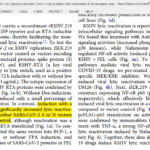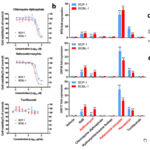Last update and review: September 5, 2021.
A short summary.
SARS-CoV-2, through one of its protein, downregulates Major Compatibility Complex I (MHC-I), one of the key immune mechanisms. Thus, cells infected with SARS-CoV-2 are less exposed to cytotoxic T-lymphocytes. Downregulation of immune surveillance mechanism is called immunoevasion.
Other viruses, HIV-1 and Kaposi’s sarcoma–associated herpes virus (KSHV), also have immunoevasion mechanisms and can cause chronic infection of the host. KSHV is an ocogenic virus. It causes cancer, in particular, in immunocompromized individuals.
In the US, the prevalence of KSHV is 10%. In Sub-Saharan Africa, the prevalence of KSHV may be as high as is 50%.
SARS-CoV-2 infection, certain drugs used to treat SARS-CoV-2, and, possibly, vaccines against SARS-CoV-2, can cause reactivation of KSHV.
Conclusions:
Both natural infection (“natural immunity”) and vaccination with the currently available vaccines against SARS-CoV-2 are understudied.
As of September 2021, we recommend avoiding both natural infections and vaccination against SARS-CoV-2. Only the most vulnerable may benefit from vaccination, though protection against hospitalization in many groups is short-lived, between 2 and 7 months. For other groups, the risks of vaccination are high, the protection, if any, is too short. Prevention measures, hygiene, prophylaxis, and early generic anti-viral treatment are effective enough to minimize the risks of infection and to prevent severe COVID-19.
Taiwan: The only bureaucrats with an OK intelligence in the world. No cases ever.

A study by Zhang et al., 2021 (1):
Some viruses that cause chronic infection down-regulating MHC-Ι expression on the surface of cells, thus evading immune surveillance.
Zhang et al., 2021 (1):
“Some viruses that cause chronic infection, such as HIV type 1 (HIV-1) and Kaposi’s sarcoma–associated herpes virus (KSHV), can disrupt antigen presentation for immune activation by down-regulating MHC-Ι expression on the surface of cells and evading immune surveillance (13–15).”
Zhang et al., 2021 (1):
“In this study, we show that SARS-CoV-2 infection leads to major histocompability complex classΙ (MHC-Ι) down-regulation both in vitro and in vivo. The viral protein encoded by open reading frame 8 (ORF8) of SARS-CoV-2, which shares the least homology with SARS-CoV among all viral proteins, directly interacts with MHC-Ι molecules and mediates their down-regulation. In ORF8-expressing cells, MHC-Ι molecules are selectively targeted for lysosomal degradation via autophagy. Thus, SARS-CoV-2–infected cells are much less sensitive to lysis by cytotoxic T lymphocytes.”
Zhang et al., 2021 (1):
“(F) Schematics showing that ORF8 mediates MHC-Ι lysosome degradation through an autophagy-dependent pathway. In SARS-CoV-2–infected cells, ORF8 directly binds to the MHC-Ι molecule, facilitating its trafficking to autophagosome for lysosome degradation. The data were shown as mean±SD (error bars). Student’sttest was used.P<0.05 indicates statistically significance difference; *P<0.05; **P<0.01; ***P<0.001.”

A study by Chen, Plaisance-Bonstaff et al., 2021 (2).
SARS-CoV-2 proteins and some currently used anti COVID-19 drugs are able to induce lytic reactivation of Kaposi’ s sarcoma-associated herpesvirus (KSHV), one of major human oncogenic viruses.
Chen, Plaisance-Bonstaff et al., 2021 (2).
“In the current study, we report that SARS-CoV-2 encoded proteins and some currently used antiCOVID-19 drugs are able to induce lytic reactivation of Kaposi’ s sarcoma-associated herpesvirus (KSHV), one of major human oncogenic viruses, through manipulation of intracellular signaling pathways. Our data indicate that those KSHV + patients especially in endemic areas exposure to COVID-19 or undergoing the treatment may have increased risks to develop virus-associated cancers, even after they have fully recovered from COVID-19.”
“Induction with a low dose of Dox (doxycycline) induction significantly increased lytic reactivation in cells transfected with either SARS-CoV-2 S or N vectors when compared to vector control.”

KSHV is an oncogenic virus from the human γ-herpesvirus subfamily and has two alternating life-cycle programs following primary infection in host cells, the latent and lytic phases.
Chen, Plaisance-Bonstaff et al., 2021 (2).
“KSHV is the etiologic agent of several human cancers including Kaposi’ s sarcoma (KS), primary effusion lymphoma (PEL), and multicentric Castleman’ s disease (MCD) 7, 8, which are mostly seen in immunosuppressed patients. KS is an endothelialoriginated multicentric malignant neoplasm, while PEL and MCD represent two types of B-cell lineage disorders 9. This oncogenic virus belongs to the human γ-herpesvirus subfamily and has two alternating life-cycle programs following primary infection in host cells, the latent and lytic phases 10. During latency, viral genomes persist as circular episomes with no progeny virion produced and only a limited number of latencyassociated genes are expressed. After entering the lytic phase, almost all viral genes are expressed, followed by the replication and release of mature virions. Recent findings indicate that both viral latent and lytic proteins play a pivotal role in the initiation and progression of virus-associated cancers 11. Here we seek to understand if COVID-19 infection and its related treatments affect KSHV replication and increase the risk of developing virusassociated cancers, and if so how these mechanisms work.”
Azithromycin (an antibiotic) and Nafamostat mesylate (a synthetic serine protease inhibitor), induced KSHV lytic reactivation in a dose-dependent manner with production of mature virions.
Chen, Plaisance-Bonstaff et al., 2021 (2).
“We next examined whether several drugs currently used for treatment of COVID-19 patients may affect KSHV lytic reactivation. A total of 6 drugs were used in our study, including Azithromycin, Chloroquine diphosphate, Hydroxychloroquine sulfate, Nafamostat mesylate, Remdesivir, and Tocilizumab 14–17. We treated iSLK.219 cells with and without Dox induction to screen these drugs and found that two of these drugs, Azithromycin (an antibiotic) and Nafamostat mesylate (a synthetic serine protease inhibitor), induced KSHV lytic reactivation in a dose-dependent manner with low dose Dox induction (Fig. 2 a and Supplementary Fig. 2). Importantly, both Azithromycin and Nafamostat mesylate treatment promoted production of mature virions.”
The seroprevalence of KSHV infection in the general population of the United States is less than 10%, but in most of sub-Saharan Africa, the overall seroprevalence is more than 50%.
Chen, Plaisance-Bonstaff et al., 2021 (2).
“The seroprevalence of KSHV infection in the general population of the United States is less than 10%, but in most of sub-Saharan Africa, the overall seroprevalence is more than 50%18. Since mother-to-child transmission of KSHV through saliva is the most common route of transmission, there is a high prevalence of early childhood KSHV infection in some areas 19–21. Moreover, KS has now become one of the most “common overall childhood cancers throughout the central, eastern, and southern regions of Africa 22.
The seroprevalence of KSHV infection is greatly increased in other sub-populations such as HIV-infected individuals, homosexual men, and organ transplant recipients.
Chen, Plaisance-Bonstaff et al., 2021 (2).
“In addition, the seroprevalence of KSHV infection is greatly increased in other sub-populations such as HIV-infected individuals, homosexual men, and organ transplant recipients 18. Interestingly, recent case reports found out the reactivation of several herpesviruses in a small number of COVID-19 patients which supporting this possibility 24–26. Third, it remains unclear whether pre-existing KSHV may affect SARS-CoV-2 infection, especially because it is a member of the herpesvirus family which can easily establish lifelong infection in a host.”
ACE2, the expression of major receptor of SARS-CoV-2, and that of CD147, another receptor of SARS-CoV-2, in KSHV-infected tissues.
Chen, Plaisance-Bonstaff et al., 2021 (2).
“We reported here that expression of ACE2, the major receptor of SARS-CoV-2, was increased in AIDS-KS tissues, although it remains unknown how KSHV may regulate ACE2 in infected cells. We previously demonstrated that KSHV de novo infection upregulated the expression of one multifunctional glycoprotein, CD147 (also named as Emmprin or Basigin), which was also strongly expressed in KS tissues 27, 28. Interestingly, CD147 was recently found to be one of co-receptors to facilitate SARS-CoV-2 entry and invasion of host cells 29. Therefore, it will be interesting to explore the potential association between KSHV and these SARS-CoV-2 receptors or coreceptors in different types of host cells.”
Limitations : “we did not infect cells with the live virus of SARS-CoV-2 because we do not have access to the virus.”
Chen, Plaisance-Bonstaff et al., 2021 (2).
“There are a few limitations and unanswered questions in our study. First, we did not infect cells with the live virus of SARS-CoV-2 because we do not have access to the virus. However, because the S and N proteins represent major and abundant structural proteins of SARS-CoV-2, it is expected that the live virus would display similar effectson KSHV induction. Second, because the KSHV test is not a routine examination in COVID-19 patients, clinical data are not yet available to support our findings.”
Methods
Cell culture and reagents.
Chen, Plaisance-Bonstaff et al., 2021 (2).
“Human iSLK.219 cells are latently infected with a recombinant rKSHV.219 virus and contain a doxycycline (Dox)-inducible RTA, constructed and named by Dr. Don Ganem’s lab 12 . The rKSHV.219 virus expresses both the redfluorescent protein (RFP) under the control of KSHV lytic PAN promoter and the greenfluorescent protein (GFP) under the control of the elongation factor 1 promoter (EF-1α) 30 . HEK293T (Human embryonic kidney 293T) cells and KSHV+PEL cell lines, BCP-1 and BCBL-1, were purchased from American Type Culture Collection (ATCC) and cultured as recommended by the manufacturer. The anti-COVID-19 drugs: Azithromycin, Chloroquine diphosphate, Hydroxychloroquine sulfate, Nafamostat mesylate, Remdesivir, and Tocilizumab were purchased from Selleck Chemicals. All the other chemicals if not indicated specifically were purchased from Sigma-Aldrich.”
Plasmids transfection.
Chen, Plaisance-Bonstaff et al., 2021 (2).
“Human iSLK.219 cells were transfected with recombinant vectors of SARS-CoV-2 spike protein (S), nucleocapsid protein (N) (both purchased from Sino Biological), pCR3.1-RTA (a gift from Dr. Yan Yuan, University of Pennsylvania) 31 , pFLAG-CMV2-p65 (pFLAG-p65, a gift from Dr. Ren Sun, University of California Los Angeles)32 , or vector controls, using LipofectamineTM 3000 reagent (Invitrogen). Transfection efficiency was normalized through cotransfection of a lacZ reporter construct and determination of β-galactosidase activity using a commercialβ-galactosidase enzyme assay system (Promega).”
Chen, Plaisance-Bonstaff et al., 2021 (2).
“aBCBL-1 and BCP-1 cells were treated with a dose range of 6 anti-COVID-19 drugs, for 72 h, then the cell proliferation status was examined using the WST-1 cell proliferation assays (Roche).b, cCells were treated with Azithromycin (10µM), Chloroquine diphosphate (10µM), Hydroxychloroquine sulfate (10µM), Nafamostat mesylate (10µM), Remdesivir (3µM), Tocilizumab (20µg/mL), respectively, for 72 h, then the transcripts of representative lytic genes were quantified by using qRT-PCR. Protein expression was measured by immunoblots.dThe supernatants from drug-treated cells above were collected to infect naive HEK293T cells, then viral genome levels were quantified by using qPCR with Lana-specific primers. The sodium butyrate (NaB, 0.3 mM) was used as a positive control. Error bars represent S.D. for 3 independent experiments, **p< 0.01 (vs the vehicle control).”

Other figures from the study by Chen, Plaisance-Bonstaff et al., 2021 (2).


Conclusions:
Both natural infection (“natural immunity”) and vaccination with the currently available vaccines against SARS-CoV-2 are understudied.
As of September 2021, we recommend avoiding both natural infections and vaccination against SARS-CoV-2. Only the most vulnerable may benefit from vaccination, though protection against hospitalization in many groups is short-lived, between 2 and 7 months. For other groups, the risks of vaccination are high, the protection, if any, is too short. Prevention measures, hygiene, prophylaxis, and early generic anti-viral treatment are effective enough to minimize the risks of infection and to prevent severe COVID-19.
Taiwan: The only bureaucrats with an OK intelligence in the world. No cases ever.

Selected references:
1. Zhang et al. The ORF8 protein of SARS-CoV-2 mediates immune evasion through down-regulating MHC-Ι. PNAS2021 Vol. 118 No. 23 e2024202118
2. Chen, Plaisance-Bonstaff et al. SARS-CoV-2 proteins and anti-COVID-19 drugs induce lytic reactivation of an oncogenic virus. Commun Biol 4, 682 (2021).





